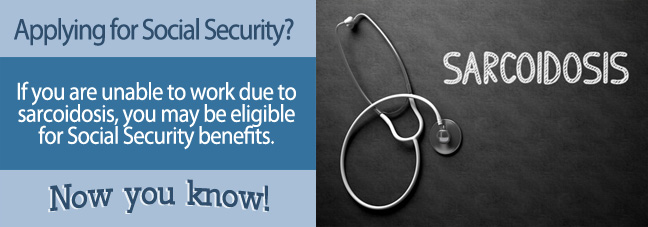Sarcoidosis is an inflammatory disease in which the body forms clumps of cells, or granulomas, in one or more organs of the body. The disorder can impact nearly body system, but most commonly affects the lungs, heart, skin, eyes, and lymph nodes.
While some individuals with sarcoidosis can have very few symptoms and live a relatively healthy life, others are impacted so severely that the disease can cause organ failure or even death.
If you have been diagnosed with sarcoidosis and are unable to work, you might be eligible for financial assistance through the Social Security Administration (SSA). Older adults, typically those over the age of 50, have a more significant advantage when it comes to qualifying for Social Security Disability Insurance (SSDI) benefits.
As we age, it becomes increasingly difficult to learn and retain information, such as a new line of employment. Further, employers are less likely to hire older individuals as compared to younger people, particularly if they are aware that the older candidate is ill. The SSA considers an applicant’s age when determining disability benefits. Depending on your education and skill level, once you reach the age of 50, the SSA might turn to the “grid rules” for assistance in determining your disability status.
Meeting a Blue Book Listing for Sarcoidosis
The Social Security Administration (SSA) utilizes a medical guide called a “Blue Book” to help determine if a person is disabled. The Blue Book is categorized by body systems and lists several conditions and their associated symptoms that a person must have to be considered disabled.
Unlike many other illnesses, sarcoidosis does not have its own listing in the Blue Book. Instead, an individual with sarcoidosis would be evaluated under the listing for whatever body organ is impacted by the disease. For example, some individuals with sarcoidosis have lung difficulties. As such, lung function tests might show that they meet or equal a listing in section, 3.02 Chronic Respiratory Disorders.
Keep in mind that even if you don’t meet one particular listing, if your symptoms are equal in severity to those in any given category, you may still be considered disabled. Further, the SSA will take into account all of your combined symptoms when making a decision. For example, if your sarcoidosis affects your lungs, heart, and vision, the SSA might consider you disabled due to the sum of your symptoms. If you still do not meet or equal a listing in the Blue Book, and you are above the age of 50, the SSA will utilize the “grid rules.”
Grid Rules and Sarcoidosis
The grid rules, also referred to as the Medical-Vocational Guidelines, takes into account the age, education, and previous work experience of an applicant. Further, the grid rules require the SSA to determine the physical capabilities of an individual, utilizing a residual functional capacity (RFC) assessment. The RFC specifies what type of work an individual can perform given their current condition, ranging from sedentary work to very heavy work. The grid rules can only be applied to those who are given a sedentary, light, or medium RFC.
The grid rules benefit those who are older, less-educated, and possess less transferable skills. For example, if you are applying for benefits for sarcoidosis and you are a 54-year-old college-educated teacher, you are less likely to be awarded disability benefits than if you were a 55-year-old high school educated line-chef.

What Type of Work Can Someone with Sarcoidosis Do?
As noted earlier, sarcoidosis affects individuals very differently. The severity of your illness, as well as the body systems impacted, will determine the type of work that you can perform. Most individuals with sarcoidosis suffer from extreme fatigue that is not relieved by sleep. As a result, it makes sense that someone with this condition work in a field that is not too strenuous. It would probably be difficult for most individuals with sarcoidosis to work in jobs that require heavy lifting and walking.
Additionally, due to the impact that sarcoidosis has on the lungs, it is recommended that people with the disease avoid jobs that involve heavy fumes or high levels of dust, as this could cause further damage to the lungs. For example, someone with sarcoidosis might have difficulty working as a painter or a car mechanic.
As a general rule, sedentary work might be best suited for individuals with sarcoidosis.
Should I Discuss My Case with a Disability Lawyer or Advocate?
As there is no specific Blue Book listing for sarcoidosis, it might be difficult to win your disability case without the assistance of an experienced disability lawyer. Social Security attorneys are skilled at determining the best route for your specific situation, including which Blue Book listings you might meet or equal.
Further, the Social Security grid rules are complex and certainly open to interpretation. A lawyer will be able to help you determine if you would qualify for disability benefits using the grid rules, and how to best prepare your case as such. As Disability Lawyers do not get compensated unless you win your case, you really have nothing to lose.